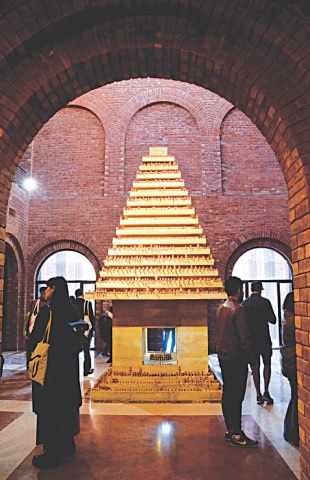
Many of the world’s nations were once under colonial rule but some witnessed totalitarian regimes and communism. As a result, in contemporary art, it has become important for artists to create art that raises questions about identity, representation, censorship and what it means to be a nation in the aftermath of such pivotal events.
These concerns define many of the works that are currently on display on 13 sites around the city for the second edition of the Lahore Biennale.
Titled Between the Sun and the Moon, this year’s theme reflects how the inhabitants of the Middle East and Central Asia once lived in harmony with nature and used the knowledge of stars to navigate across sea and land. Today, this relationship has been replaced and it is fraught with climate change and widespread conflict. How artists should intervene in such a troubled world is a question that remains at the forefront in the Biennale this year.
Thirteen artists are currently exhibiting at one of the sites — The Punjab Institute of Language, Art and Culture (PILAC) building at Gaddafi Stadium. Among artists worth mentioning is Pakistani artist Imran Ahmad Khan, whose monumental ziggurat resembling a simplified form of a Buddhist temple dominates the ground floor. He pays a fitting homage to this region’s rich culture through the use of artefacts, food history and historical forms. Hundreds of little terracotta figurines are seated on each successive step of the pyramid as it soars upwards. His collated display of a variety of actual flatbreads (naan) preserved and nailed to an entire wall from different regions has garnered a lot of attention.

Saba Khan’s ‘Pak Khawateen Painting Club’ is an ongoing research project that documents and opens the floor for debate on the development of hydropower dams in Pakistan. Dressed as patriotic girl guides, the artists actually embarked on an intensive research and documentation tour of the north of the country. As one enters the space, one can see space-age geometric forms recreated to resemble fragments of dam control rooms from the ’60s, with their distinct green colour. These forms become ‘oracles’ that tell stories of displacement and cultural loss as they contain artefacts, videos, recordings, projections and two zines that document the mock Painting Club’s journey.
Artists at the Lahore Biennale are vocal about commenting on the connection of artists to society, politics and history
Of the three videos, Afghan artist Lida Abdul’s dream-like video ‘What We Have Overlooked’ stands out for its poignancy and symbolism, as viewers watch a man who slowly submerges and drowns himself. As he sinks, his flag also vanishes along with everything it represents.
Naiza Khan talks about ecology, colonialism and cities with her brass sculptural maps of cities within Pakistan, India and Bangladesh. These sculptures also contain a selection of cast objects that seem to resemble debris cast aside after a storm. The oral narration of a weather report from 1939, discovered at an Observatory from Manora Island, adds another layer to the work, making one question whether the truth lies somewhere between fiction and reality. Her videos titled ‘Sticky Rice and Other Stories’ contain interviews and a documentation of life and tourism in Manora. It is worth mentioning that Khan became the first Pakistani artist to exhibit at the prestigious Venice Biennale in 2019 and these works which were on display there have been unveiled at the Lahore Biennale for the first time.

Afghan-American artist Mariam Ghani’s film What We Left Unfinished, is an engaging account of the making of five unfinished films during the communist era in Afghanistan. The film features interviews, film clips and meticulous research on the cinematic history of Afghanistan, told in the light of censorship and resistance.
At the Lahore Museum, famous Algerian artist Rachid Koraïchi’s lithographs and embroidered tapestries stand out. They are suffused with colour and laden with letters and signage that draws from Arabic calligraphy, talismanic manuscripts and a deep understanding of many languages, religions and cultures. The works are an impressive sight to behold.
Turkish artist Hera Büyüktaçyan and Berlin-based Pakistani artist Hajra Haider’s video The Infinite Nectar documents decaying parts of Sikh temples in the Walled City in Lahore, as they reflect upon their place in the urban fabric of a city that witnessed the trauma of Partition.
This year at the Biennale, alternative voices from other regions that are critiquing history, society and even geography have been given a strong platform. Could this be a sign of even better things to come?
“Lahore Biennale 02” is being displayed across cultural and heritage sites throughout Lahore from January 26 to February 29, 2020
Published in Dawn, EOS, February 9th, 2020














































Dear visitor, the comments section is undergoing an overhaul and will return soon.